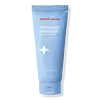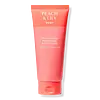What's inside
What's inside
 Key Ingredients
Key Ingredients

 Benefits
Benefits

 Concerns
Concerns

 Ingredients Side-by-side
Ingredients Side-by-side

Water
Skin ConditioningCetyl Ethylhexanoate
EmollientHydrogenated Polydecene
EmollientButylene Glycol
HumectantPolyglyceryl-3 Methylglucose Distearate
Emulsifying1,2-Hexanediol
Skin ConditioningNiacinamide
SmoothingCetearyl Alcohol
EmollientCoco-Caprylate/Caprate
EmollientSalicylic Acid
MaskingChamaecyparis Obtusa Water
MaskingGlyceryl Glucoside
HumectantSaccharomyces/Rice Ferment Filtrate
Skin ConditioningFructan
Skin ConditioningAloe Barbadensis Leaf Extract
EmollientCucumis Sativus Fruit Extract
EmollientGlycerin
HumectantHamamelis Virginiana Leaf Extract
Skin ConditioningPapain
Skin ConditioningGlycolic Acid
BufferingMalpighia Glabra Fruit Extract
Skin ConditioningPerilla Ocymoides Seed Extract
AntioxidantSalvia Hispanica Seed Extract
EmollientPrunella Vulgaris Extract
AntioxidantFucus Vesiculosus Extract
EmollientGlucose
HumectantBeta-Glucan
Skin ConditioningBetaine
HumectantAllantoin
Skin ConditioningCaesalpinia Spinosa Gum
Skin ConditioningSorbitan Olivate
EmulsifyingPotassium Hydroxide
BufferingUlmus Davidiana Root Extract
Skin ConditioningCetearyl Olivate
Polyglyceryl-4 Caprate
EmulsifyingGlyceryl Stearate Se
EmulsifyingPolyacrylate Crosspolymer-6
Emulsion StabilisingCaprylyl Glycol
EmollientWater, Cetyl Ethylhexanoate, Hydrogenated Polydecene, Butylene Glycol, Polyglyceryl-3 Methylglucose Distearate, 1,2-Hexanediol, Niacinamide, Cetearyl Alcohol, Coco-Caprylate/Caprate, Salicylic Acid, Chamaecyparis Obtusa Water, Glyceryl Glucoside, Saccharomyces/Rice Ferment Filtrate, Fructan, Aloe Barbadensis Leaf Extract, Cucumis Sativus Fruit Extract, Glycerin, Hamamelis Virginiana Leaf Extract, Papain, Glycolic Acid, Malpighia Glabra Fruit Extract, Perilla Ocymoides Seed Extract, Salvia Hispanica Seed Extract, Prunella Vulgaris Extract, Fucus Vesiculosus Extract, Glucose, Beta-Glucan, Betaine, Allantoin, Caesalpinia Spinosa Gum, Sorbitan Olivate, Potassium Hydroxide, Ulmus Davidiana Root Extract, Cetearyl Olivate, Polyglyceryl-4 Caprate, Glyceryl Stearate Se, Polyacrylate Crosspolymer-6, Caprylyl Glycol
Water
Skin ConditioningIsopropyl Myristate
EmollientLactic Acid
BufferingUrea
BufferingGlycolic Acid
BufferingPotassium Hydroxide
BufferingGlycerin
HumectantCetearyl Alcohol
EmollientCetearyl Olivate
Sorbitan Olivate
EmulsifyingGlyceryl Stearate Se
EmulsifyingSqualane
EmollientCentella Asiatica Extract
CleansingBisabolol
MaskingArtemisia Vulgaris Extract
Skin ConditioningLactobacillus/Aloe Barbadensis Ferment Filtrate
Skin ConditioningPrunus Mume Fruit Extract
HumectantPyrus Malus Fruit Extract
Skin ConditioningCarica Papaya Fruit Extract
Skin ConditioningVitis Vinifera Fruit Extract
Skin ConditioningSodium Hyaluronate
HumectantButyrospermum Parkii Butter
Skin ConditioningCollagen Extract
Skin ConditioningTremella Fuciformis Extract
HumectantLactobacillus/Soybean Ferment Extract
Skin ConditioningDioscorea Japonica Root Extract
Skin Conditioning1,2-Hexanediol
Skin ConditioningHydroxyethyl Acrylate/Sodium Acryloyldimethyl Taurate Copolymer
Emulsion StabilisingHordeum Distichon Extract
Skin ProtectingCalendula Officinalis Flower Extract
MaskingTromethamine
BufferingHectorite
AbsorbentXanthan Gum
EmulsifyingButylene Glycol
HumectantCaprylhydroxamic Acid
Caprylyl Glycol
EmollientEthylhexylglycerin
Skin ConditioningWater, Isopropyl Myristate, Lactic Acid, Urea, Glycolic Acid, Potassium Hydroxide, Glycerin, Cetearyl Alcohol, Cetearyl Olivate, Sorbitan Olivate, Glyceryl Stearate Se, Squalane, Centella Asiatica Extract, Bisabolol, Artemisia Vulgaris Extract, Lactobacillus/Aloe Barbadensis Ferment Filtrate, Prunus Mume Fruit Extract, Pyrus Malus Fruit Extract, Carica Papaya Fruit Extract, Vitis Vinifera Fruit Extract, Sodium Hyaluronate, Butyrospermum Parkii Butter, Collagen Extract, Tremella Fuciformis Extract, Lactobacillus/Soybean Ferment Extract, Dioscorea Japonica Root Extract, 1,2-Hexanediol, Hydroxyethyl Acrylate/Sodium Acryloyldimethyl Taurate Copolymer, Hordeum Distichon Extract, Calendula Officinalis Flower Extract, Tromethamine, Hectorite, Xanthan Gum, Butylene Glycol, Caprylhydroxamic Acid, Caprylyl Glycol, Ethylhexylglycerin
Ingredients Explained
These ingredients are found in both products.
Ingredients higher up in an ingredient list are typically present in a larger amount.
1,2-Hexanediol is a synthetic liquid and another multi-functional powerhouse.
It is a:
- Humectant, drawing moisture into the skin
- Emollient, helping to soften skin
- Solvent, dispersing and stabilizing formulas
- Preservative booster, enhancing the antimicrobial activity of other preservatives
Butylene Glycol (or BG) is used within cosmetic products for a few different reasons:
Overall, Butylene Glycol is a safe and well-rounded ingredient that works well with other ingredients.
Though this ingredient works well with most skin types, some people with sensitive skin may experience a reaction such as allergic rashes, closed comedones, or itchiness.
Learn more about Butylene GlycolCaprylyl Glycol is a humectant and emollient, meaning it attracts and preserves moisture.
It is a common ingredient in many products, especially those designed to hydrate skin. The primary benefits are retaining moisture, skin softening, and promoting a healthy skin barrier.
Though Caprylyl Glycol is an alcohol derived from fatty acids, it is not the kind that can dry out skin.
This ingredient is also used as a preservative to extend the life of products. It has slight antimicrobial properties.
Learn more about Caprylyl GlycolCetearyl alcohol is a mixture of two fatty alcohols: cetyl alcohol and stearyl alcohol. It is mainly used as an emulsifier. Emulsifiers help prevent the separation of oils and products. Due to its composition, it can also be used to thicken a product or help create foam.
Cetearyl alcohol is an emollient. Emollients help soothe and hydrate the skin by trapping moisture.
Studies show Cetearyl alcohol is non-toxic and non-irritating. The FDA allows products labeled "alcohol-free" to have fatty alcohols.
This ingredient is usually derived from plant oils such as palm, vegetable, or coconut oils. There is debate on whether this ingredient will cause acne.
Due to the fatty acid base, this ingredient may not be Malassezia folliculitis safe.
Learn more about Cetearyl AlcoholCetearyl Olivate is an emulsifier and texture enhancer. It is derived from the fatty acids of olive oil and Cetearyl alcohol, and is biodegradable.
As an emulsifier, it is used to prevent oils and waters from separating. It can also
Manufacturers use the name Olivem 1000. This ingredient has been found to preserve the natural microbiome of skin. Having a healthy microbiome helps keep our skin healthy and protects against harmful bacteria. This ingredient is grouped with Sorbitan Olivate under the name Olivem 1000.
Learn more about Cetearyl OlivateGlycerin is already naturally found in your skin. It helps moisturize and protect your skin.
A study from 2016 found glycerin to be more effective as a humectant than AHAs and hyaluronic acid.
As a humectant, it helps the skin stay hydrated by pulling moisture to your skin. The low molecular weight of glycerin allows it to pull moisture into the deeper layers of your skin.
Hydrated skin improves your skin barrier; Your skin barrier helps protect against irritants and bacteria.
Glycerin has also been found to have antimicrobial and antiviral properties. Due to these properties, glycerin is often used in wound and burn treatments.
In cosmetics, glycerin is usually derived from plants such as soybean or palm. However, it can also be sourced from animals, such as tallow or animal fat.
This ingredient is organic, colorless, odorless, and non-toxic.
Glycerin is the name for this ingredient in American English. British English uses Glycerol/Glycerine.
Learn more about GlycerinGlyceryl Stearate Se is a self-emulsifying (SE) form of glyceryl stearate. Self-emusifying means this ingredient automatically blends with water. It is an emulsifier, emollient, and cleansing agent.
As an emulsifier, Glyceryl Stearate Se prevents ingredients such as oil and water from separating. It is also a surfactant, meaning it helps cleanse the skin. Surfactants help gather oil, dirt, and other pollutants so they may be rinsed away easily.
Emollients help your skin stay smooth and soft. It does so by creating a film on top of the skin that helps trap moisture in.
Learn more about Glyceryl Stearate SeGlycolic Acid is arguably the most famous alpha hydroxy acid (AHA) with tons of research backing its benefits.
It is found naturally in sugar cane but the form used in skincare is usually synthetic for purity and stability.
Glycolic acid removes the top layer of dead skin cells to allow newer and fresher ones to emerge.
AHAs work by breaking down the structural “glue” that holds old skin cells in place. When that buildup is gone, your skin can renew itself more efficiently.
Research also shows glycolic acid stimulates collagen production, helping to firm and thicken the skin over time. This is one of its biggest advantages over other AHAs.
Overall, glycolic acid helps with:
Fun fact: Glycolic acid boosts skin hydration by helping it produce molecules that increase hyaluronic acid naturally.
To work best, glycolic acid products should have a pH between 3-4 (that’s where exfoliation is most effective but still gentle on skin).
The pH and concentration of a product are key to its effectiveness:
It is normal to feel a slight stinging sensation when using glycolic acid. This usually fades as your skin adjusts.
Because glycolic acid has the smallest molecular size in the AHA family, it can penetrate deeper, which enhances its effectiveness but also makes it more likely to irritate sensitive skin.
If your skin is very sensitive or prone to rosacea, glycolic acid may be too strong; in that case, try milder options like lactic acid or a PHA instead.
Recent studies suggest glycolic acid might even help protect against UV damage. But don’t skip sunscreen! Freshly exfoliated skin is more sensitive to the sun.
Glycolic acid is a skincare superstar. It smooths, brightens, hydrates, and firms the skin. Unless you’re highly sensitive, it’s well worth adding to your routine.
Read more about some other popular AHA's here:
Learn more about Glycolic AcidPotassium hydroxide is commonly known as caustic potash. It is used to fix the pH of a product or as a cleaning agent in soap. In cleansers, it is used for the saponification of oils.
Sapnification is the process of creating fatty acid metal salts from triglycerides and a strong base. During this process, Potassium Hydroxide is used up and is not present in the final product.
Using high concentrations of Potassium Hydroxide have shown to irritate the skin.
Learn more about Potassium HydroxideSorbitan Olivate is created from the fatty acids in olive oil and sorbitol.
This ingredient is an oil in water emulsifier. It helps stabilize a product by preventing oils and waters from separating. Sorbitan Olivate also helps hydrate the skin.
Manufacturers sell sorbitan olivate under the name OliveM 1000. OliveM 1000 a multifunctional ingredient. It is self-emulsifying. According to a manufacturer, OliveM 1000 does not disrupt natural skin biome.
Due to its olive oil base, this ingredient may not be fungal-acne safe.
Learn more about Sorbitan OlivateWater. It's the most common cosmetic ingredient of all. You'll usually see it at the top of ingredient lists, meaning that it makes up the largest part of the product.
So why is it so popular? Water most often acts as a solvent - this means that it helps dissolve other ingredients into the formulation.
You'll also recognize water as that liquid we all need to stay alive. If you see this, drink a glass of water. Stay hydrated!
Learn more about Water